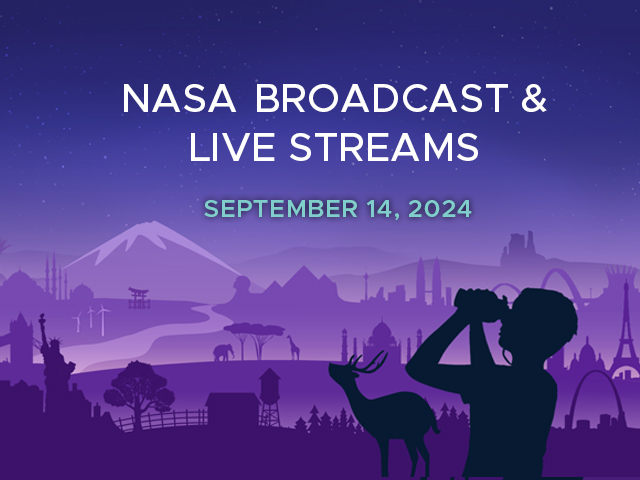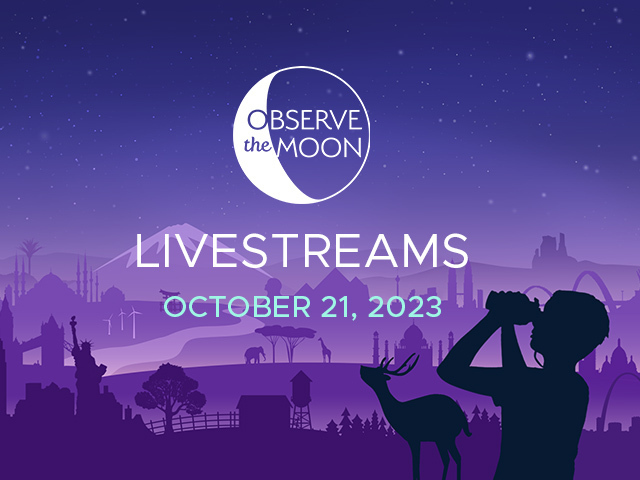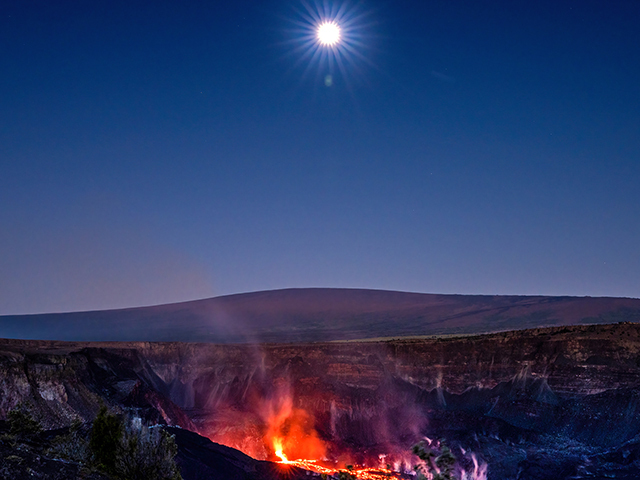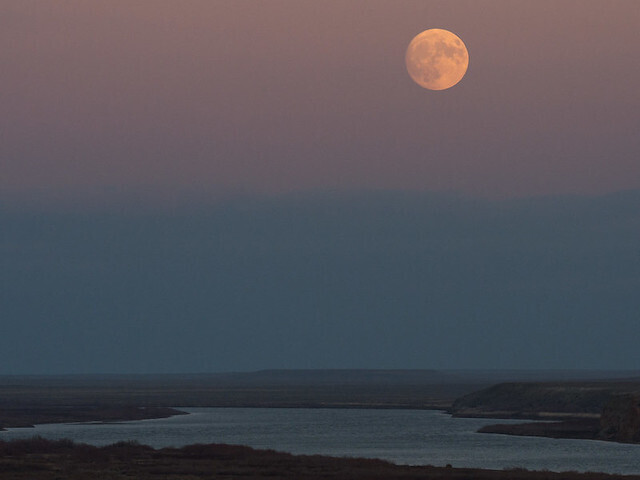News | January 1, 2018
Full Moon Blog: January 2018
.jpg?disposition=inline)
The moon, or supermoon, is seen as it sets by the Lincoln Memorial on Monday, Nov. 14, 2016 in Washington. A supermoon occurs when the moon's orbit is closest (perigee) to Earth. Early Monday morning, the moon was the closest it has been to Earth since 1948 and it appeared 30 percent brighter and 14 percent bigger than the average monthly full moon. Photo Credit: NASA/Joel Kowsky
The Next Full Moon is a Supermoon, the Long Night Moon, the Wolf Moon, the Ice Moon, the Old Moon and the Moon After Yule
The next full Moon will be on Monday night, January 1, 2018, appearing "opposite" the Sun (in Earth-based longitude) at 9:24 PM EST. Since this is after midnight in Universal Time, most store-bought calendars show this full Moon on Tuesday, January 2nd. The Moon will appear full for about three days around this time, from Sunday evening through Wednesday morning.
Because this full Moon occurs less than 5 hours after perigee (the Moon's closest approach to the Earth in its orbit) this full Moon is also the closest of three "Supermoons" this winter. For this perigee the Moon will appear 14% wider in diameter than it will appear when at apogee later in January, making the light of the full Moon 30% brighter than it would be if the full Moon were at apogee.
This will be an unusually bright Supermoon. The orbit of the Earth-Moon system around the Sun is not a perfect circle, and since the intensity of sunlight changes as the square of the distance, the sunlight reaching the Earth (and the Moon) is about 6.7% brighter when the Earth is closest to the Sun in its orbit (called perihelion) than when it is farthest from the Sun (called aphelion). This full Moon occurs a little over a day before perihelion. Because we are nearly at our closest to the Sun for the year, the sunlight reflecting off the Moon towards the Earth will be near its brightest.
As the full Moon closest to the Winter Solstice, another European name for this Moon is the Long Night Moon. Because the plane of the Moon's orbit around the Earth is nearly parallel with the plane of the Earth's orbit around the Sun, when the path of the Sun appears lowest in the sky for the year the path of the full Moon (opposite the Sun) appears highest in the sky. For the Washington, DC, area, on Monday evening, January 1, 2018, moonrise will be at 4:52 PM (about 5 minutes before sunset), sunset will be at 4:57 PM, the Moon will reach its highest point of 70.8 degrees above the horizon on Tuesday morning at 12:18 AM, sunrise will be at 7:27 AM, and moonset at 7:44 AM EST (17 minutes after sunrise). The Moon will be in the sky for 14 hours 52 minutes, with all but 22 minutes of this when the Sun is down, making this the longest full Moon night of the year. This means you will have a long night to enjoy this unusually bright Supermoon.
As the first full Moon of Winter, this Moon is known as the Wolf Moon. The Maine Farmer's Almanac first published Indian names for the full Moons in the 1930's, and according to this almanac, this name came from the packs of wolves that howled hungrily outside the Native American villages amid the cold and deep snows of winter. Another name is the Ice Moon. Some tribes called this the Snow Moon but most applied this to the second full Moon of winter. Europeans called this the Old Moon or the Moon After Yule (an old Germanic name for the solstice celebration now associated with Christmas).
In lunisolar calendars the months change with the new Moon and full Moons fall in the middle of the lunar months. This full Moon is the middle of the eleventh month of the Chinese calendar and Teveth in the Hebrew calendar. In the Islamic calendar the months start with the first sighting of the waxing crescent Moon a few days after the New Moon. This full Moon is near the middle of Rabi' al-Thani, the fourth month of the Islamic year.
As usual, the wearing of suitably celebratory celestial attire is encouraged in honor of the full Moon.
As for other celestial events between now and the full Moon after next:
As winter continues, the daily periods of sunlight are short but getting longer. The length of a day (as measured for example from noon to noon on a sundial) varies through the year. Around the winter solstice, although the periods of daylight are short, the length of a solar day is slightly longer than the 24 hour average. Because of this offset in the length of the solar day the latest sunrises of the year (ignoring Daylight Savings Time) occur after the solstice. For the Washington, DC area, the latest sunrises of the year will occur on the 10 days from Sunday, December 31, 2017 through Tuesday, January 9, 2018. Rounded to the minute, sunrise will be at 7:27 AM EST across these dates. On the day of the next full Moon, Monday, January 1, 2018, morning twilight will begin at 6:24 AM, sunrise will be one of these latest sunrises at 7:27 AM, the Sun will reach a maximum altitude of 28.2 degrees at 12:12 PM, sunset will already be getting noticeably later at 4:57 PM, and evening twilight will end at 6:00 PM EST. By the day of the full Moon after next, Wednesday, January 31, 2018, morning twilight will begin at 6:15 AM, sunrise will be at 7:15 AM, the Sun will reach a maximum altitude of 33.9 degrees at 12:22 PM, sunset will be at 5:28 PM, and evening twilight will end at 6:29 PM EST.
On the evening of the first full Moon in January, as evening twilight ends, the trio of bright stars called the "Summer Triangle" will appear in the west, with Deneb the highest in the sky, at about 45 degrees above the west-northwest horizon. The bright stars of the local arm of our home galaxy, including the constellation Orion, will be rising in the east, appearing high in the south by about 11 PM. By the evening of the full Moon at the end of January, as evening twilight ends, the bright stars of the local arm of our home galaxy will appear higher in the southeast, reaching their highest in the south by about 9 PM.
On the morning of the first full Moon in January, as morning twilight begins, the planets Jupiter and Mars will appear near each other in the south-southeast about 30 degrees above the horizon. Jupiter will be the brighter of the two, with Mars to the upper right of Jupiter. The star between Jupiter and Mars will be Zubenelgenubi, the brightest star in the constellation Libra. The planet Mercury will be near its brightest and at its greatest western separation from the Sun, appearing in the east-southeast about 7 degrees above the horizon. The planet Saturn will rise in the east-southeast about 20 minutes after morning twilight begins, but still should be bright enough to be visible until about 30 minutes before sunrise. Over the next few mornings Jupiter and Mars will appear to shift closer to each other, appearing at their closest the mornings of January 6 and 7, 2018, then appearing to separate again. Through January, Mercury will appear to shift gradually closer to the horizon. Saturn will rise earlier each morning and will appear to shift closer to Mercury, appearing at their closest on the morning of January 13 before appearing to separate again. By January 19 Mercury will be just rising as morning twilight begins, and will become harder to see as it rises closer to dawn. By the day of the full Moon at the end of January, as morning twilight begins, Jupiter will appear in the south at about 34 degrees above the horizon, Mars will appear in the south-southeast at about 29 degrees above the horizon, and Saturn will appear in the southeast at about 11 degrees above the horizon.
The annual Quadrantid meteor shower is usually a strong meteor shower active until January 12, 2018, but peaks two days after the first full Moon in January, so moonlight will interfere with observing these meteors this year.
I am sending this out too late to remind you about the waxing gibbous Moon passing in front of the bright star Aldebaran (it was cloudy and snowing in our area anyway), but if you can see the Moon Saturday night, December 30, or Sunday morning, December 31, 2017, the bright star near the Moon will be Aldebaran. Aldebaran will appear to move away to the right of the Moon as the morning progresses. For the Washington, DC area, Aldebaran will set Sunday morning at 5:03 AM and the Moon will set at 5:31 AM.
On Monday, January 1, 2018, at 3:00 PM EST, the planet Mercury will be at its greatest angular separation from the Sun as seen from the Earth, called greatest western elongation, appearing half full when viewed by telescope. Because of the tilt of Mercury's orbit compared to our horizon, Mercury will appear at its highest above the horizon at the time morning twilight begins a few days before its greatest elongation.
Monday, January 1, 2018, at 4:49 PM EST, the Moon will be at perigee, its closest to the Earth for this orbit. At 356,665 km (221,559 miles), the Moon will be 12.3% closer than it will be when at apogee in mid December and mid January.
As mentioned above, the next full Moon will be on Monday, January 1, 2018, at 9:24 PM EST.
On Tuesday evening, January 2, 2018, at 7:40 PM EST (2018-Jan-03 00:40 UTC), Near Earth Object (2017 YD7), between 9 and 21 meters (30 to 68 feet) in diameter, will pass the Earth at between 4.7 and 4.8 lunar distances (nominally 4.7), traveling at 10.52 kilometers per second (23,534 miles per hour).
Just after midnight Wednesday morning, January 3, 2018, at 12:35 AM EST, the Earth will be a perihelion, its closest to the Sun for the year. The Earth will be 3.4% closer to the Sun and the sunlight reaching the Earth will be 6.9% brighter than when the Earth will be at aphelion in July. This is one of the reasons why the seasons in the Southern Hemisphere, such as in Antarctica, are more extreme than in the Northern Hemisphere. Perihelion is also when the Earth is moving the fastest in its orbit around the Sun, so if you run east at local midnight, you will be moving as fast as you can (at least in Sun-centered coordinates) for your location. T
The annual Quadrantid meteor shower will peak on Wednesday, January 3, 2018. While this shower is usually a strong meteor shower, moonlight from the nearly full Moon will make it hard to see these meteors this year.
On Thursday evening, January 4, through Friday morning, January 5, 2018, the bright star Regulus will appear below the winning gibbous Moon. For the Washington, DC area, the Moon will rise in the east-northeast at 8:19 PM and Regulus will rise at 8:37 PM EST. The Moon and Regulus will appear at their closest, less than a degree apart, on Friday morning at around 3 AM. They will still appear close when morning twilight begins Friday morning at 6:24 AM.
On Saturday morning, January 6, 2018, the bright planets Jupiter and Mars will appear near each other, less than a third of a degree apart. For the Washington, DC area, Mars will rise in the east-southeast at 2:57 AM, Jupiter will rise a minute later at 2:58 AM, and they will appear 30 degrees above the horizon in the south-southeast by the time morning twilight begins at 6:24 AM EST.
On Sunday morning, January 7, 2018, the bright planets Jupiter and Mars will appear even closer to each other, about a quarter of a degree apart. For the Washington, DC area, Jupiter will rise in the east-southeast at 2:55 AM, Mars will rise a minute later at 2:56 AM, and they will again appear 30 degrees above the horizon in the south-southeast by the time morning twilight begins at 6:24 AM EST.
Monday evening, January 8, 2018, the waning Moon will appear half-full as it reaches its last quarter at 5:25 PM EST. The Moon is like a retroreflector on a bicycle or street sign, tending to reflect more light back towards the Sun than towards other angles. Even though half of the Moon is illuminated, the last quarter Moon is only one-tenth as bright as the full Moon. Because there are more dark areas on the eastern half of the visible disk of the Moon, the last quarter Moon is fainter than the first quarter Moon.
Tuesday, January 9, 2018, at 2:01 AM EST, will be when the planet Venus passes on the far side of the Sun as seen from Earth, called superior conjunction.
On Tuesday morning, January 9, 2016, the bright star Spica will appear to the lower right of the waning half-moon. For the Washington, DC area, the Moon will rise just a little south of east at 12:38 AM and Spica will rise to the right of the Moon at 12:53 AM EST. Morning twilight will begin at 6:24 AM, 10 minutes before the Moon reaches its highest in the sky for the morning.
On Thursday morning, January 11, 2018, the bright planets Jupiter and Mars will appear to the right of, and forming a triangle with, the waning crescent Moon. For the Washington, DC area, the Moon will rise in the east-southeast at 2:35 AM, Jupiter will rise at 2:42 AM, and Mars will rise at 2:53 AM EST. They will remain visible until masked by the glow of dawn, with morning twilight beginning at 6:24 AM.
Based on National Weather Service records for National Airport, the coldest period of the year tends to be from Friday, January 12 to Monday, January 22, with an average high of 43 degrees and an average low of 28 degrees Fahrenheit.
Saturday morning, January 13, 2018, the planets Saturn and Mercury will appear less than a degree apart in the morning sky. As morning twilight begins (at 6:24 AM EST for the Washington, DC area), Saturn and Mercury will appear near each other about 3 degrees above the horizon in the east-southeast, with the Moon to the right in the southeast about 18 degrees above the horizon, the bright star Antares further to the south-southeast at about 14 degrees above the horizon, and the planets Mars and Jupiter in the south-southeast at about 30 degrees above the horizon.
Most Hindu holidays are tied to lunar events and months in lunar-solar calendar. An exception is Makar Sankranti, which is tied to when the Sun enters into the constellation Makara, marking the end of the month of the winter solstice. This year Makar Sankranti will be on Sunday, January 14, 2018.
Sunday, January 14, 2018, at 9:10 PM EST, the Moon will be at apogee, its farthest from the Earth for this orbit at 406,464 km (252,565 miles).
I expect it will be difficult to see without a very clear view of the horizon in the east-southeast and a pair of binoculars, but Monday morning, January 15, 2018, just as morning twilight begins (at 6:23 AM EST for the Washington, DC area), you might be able to see the planets Saturn and Mars to the right of the very thin, waning crescent Moon. The Moon will be only 1.5 degrees above the horizon, Mars will be about 3 degrees to the right and about the same height above the horizon, and Saturn will be farther to the right and about 4 degrees above the horizon.
Tuesday night, January 16, 2018, at 9:17 PM EST, will be the new Moon, when the Moon passes between the Earth and the Sun and will not be visible from the Earth. This marks the start of the twelfth month of the Chinese calendar and Shevat in the Hebrew calendar.
In the Islamic calendar the months start with the first sighting of the waxing crescent Moon a few days after the New Moon. Around about Thursday, January 18, 2018, will mark the beginning of Jumada al-awwal, the fifth month.
On Wednesday evening, January 24, 2018, the Moon will appear half-full as it reaches its first quarter at 5:20 PM EST.
On Friday evening, January 26, into Saturday morning, January 27, 2018, the bright star Aldebaran will appear near the waxing gibbous Moon. Aldebaran will appear to the left of the Moon as evening twilight ends, and will appear to shift closer to the Moon through the night until moonset Saturday morning (at 3:09 AM EST for the Washington, DC area).
Tuesday morning, January 30, 2018, at 4:58 AM EST, the Moon will be at perigee, its closest to the Earth for this orbit. At 358,994 km (223,069 miles), the Moon will appear 13.2% wider in diameter and 28.2% larger in area than it will have appeared when it was at apogee earlier in January.
The full Moon after next will be on Wednesday morning, January 31, 2018, at 8:27 AM EST. This full Moon will be close enough to perigee to be considered a Supermoon. As the second full Moon in January, this full Moon is also considered a Blue Moon (by a more modern definition of Blue Moon). In addition, there will be a lunar eclipse for this full Moon, which can make the Moon appear reddish in color. These make this full Moon a super blue blood Moon.






